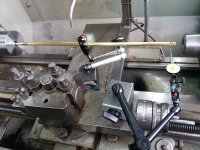Pic 3
1st boring op was actually to face off to an area that is going to be the same or bigger than the finished area.This is so that 1, we have a clean face to start boring from, and 2, gives an indication as to how much material is going to be left for the overall height and how far we need to bore through.The facing was done quite quickly/course. A finish face will be done after the bore has been finished.
Rough out the hole with the boring bar with what ever cuts the power allows or the rigidity of the machine allows. Stalling the lathe is real bad news for cutting tool edges, especially carbide.There is no point in taking too big a cuts and getting the work piece hot. This can cause in extreme cases, the work piece to become loose, when the part cools down, and possibly come loose or even out of the chuck.
Think about the cut sizes that can be taken, and the amount to be the finish cut depth.
The finish path cut depth is determined by a lot of things, like how rigid the turning/boring bar is, the tool radius and the material being cut. As a general rule, you can often go ,1/4 to 1/2 the tip radius as the depth of cut, so I used a 0.4mm (0.016 inches )radius tool, so the depth of finish cuts will be about 0.1mm to 0.2mm or (0.004 to 0.008 inches) or 0.2mm to 0.4mm diameter(0.008 to 0.016 inches). Feed rate will be between 1/4 the tip radius to 1/8, .05mm to 0.1mm, (.002 to .004 inches) per rev feed rate.
So my bore is to finish at 43.92mm to suite my router. So I am going to ruf the bore to about 43.5 mm . Then I dial a finish feed rate pass at 43.72mm. Then measure with what ever you have, caliper, tele gauge, bore gauge mic etc. Then see how much more has to come out. Take that cut. Then check it is the correct size.looks like it was at 43.7, so took a 0.22mm finish cut to get the 43.92mm diameter.
